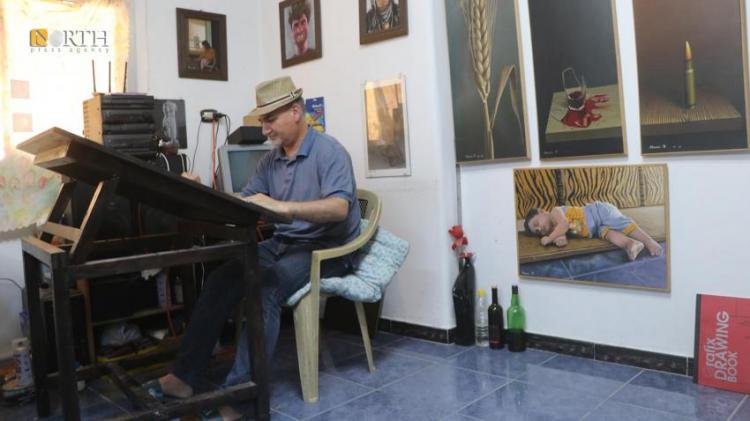Fine arts flourish among war in Syria’s Hasakah
HASAKAH, Syria (North Press) – In the basement of his house, which he has turned into his own private workshop in a popular neighborhood in the northeastern Syrian city of Hasakah, Kurdish artist Akram Bakr spends many hours drawing paintings that embody images of daily life with a professional manner that attracts one’s attention with a simple glance.
The dream of the gray-bearded man was fulfilled after he graduated from the Sabri Raphael Institute of Fine Arts in Hasakah 10 years ago.
In his art, he tends to rely on “silent nature,” Bakr says, adding that it is considered one of the most difficult plastic arts because it requires high precision in design and professionalism in performance, and it takes a long time and high cost to finish a painting.
Since his graduation, he has completed hundreds of paintings and participated in many public and private exhibitions in the Jazira region. He still maintains some of his works, which cover the walls of his house and workshop, while a number of them are still in progress.
“I work with pencils and oil colors. I use realistic art style, which differs from photography and classical arts. This art has not lost its luster from the Renaissance to the present day.”
Marginalized environment
Over the past decades, fine arts in Syria’s Jazira did not advance significantly due to the marginalized environment associated with the deteriorating economic reality of the residents of the region.
Bakr never imagined that his career would start academically, with the spark being the Syrian war, which cast a shadow on the social and economic reality and led to many of his works remaining undiscovered until now.
“Realistic art requires a stable environment, but as we know, the country has suffered from civil war for 10 years, and this has affected the artistic community and [led to] the lack of sufficient galleries.”
“It cannot be said that the public is not interested in art, but in general, there are other priorities for them, such as focusing on security and living, so art flourishes in stable and safe societies as an aesthetic case added to it,” he added.
Images of reality
During the Syrian war, most artists sought to reflect the suffering of the daily life of the population and transfer it into paintings that express the tragedy that they experienced during the past years, but Bakr says that he is trying to influence the societal situation by transforming the tools of war into aesthetic images because “life is more beautiful than war.”
“Fine art differs from one person to another, as it depends on the school from which [the individual graduates]. The expression of the deteriorating social situation is the specialty of the Expressive school. As for me, an artist who paints silent nature, I prefer turning the deteriorating situation into a state of optimism and hope,” he said.
Bakr criticizes some of his colleagues for drawing disembodied limbs, destruction, or gunfire, as they “harm the human soul.”
Lack of awareness and artistic taste
Bakr believes that the absence of the effective role of fine arts has led many to enter this field without being recognized, and that many of the works that came out to the public through drawings on the walls and making statues in public squares have become a source of mockery and criticism among a wide range of people.
He added that the most recent of these was a statue which was said to be of a dove by the People’s Municipality in the Autonomous Administration in the city of Hasakah, as it became a subject of criticism from residents of the city who say that this work is incomplete and not purposeful.
Bakr attributes the failure of the art of painting to flourish in the Jazira region to what he calls “visual pollution”, a category into which some painters fall.
“Fine art is based on simple ideas, according to aesthetic or expressive ideas, and it aims to change visual taste. There are many scenes that are harmful to the eyesight and are called visual pollution.”
During his artistic career of nearly a decade, Bakr took part in many joint exhibitions in the areas of northeastern Syria, in addition to organizing exhibitions of his own paintings within the city of Hasakah.
Bakr displays his paintings on social media because of the absence of the media interest in art. According to his convictions, “In our regions, attention is not paid to visual art, what we blame is the absence of specialized programs to show fine art to society.”
In his small workshop, Bakr is currently working on finishing a group of paintings to hold a special exhibition during the coming period, expressing the strong attachment to art by saying:
“I will keep painting as long as I breathe.”
(reporting by Delsoz Youssef, editing by Lucas Chapman)

